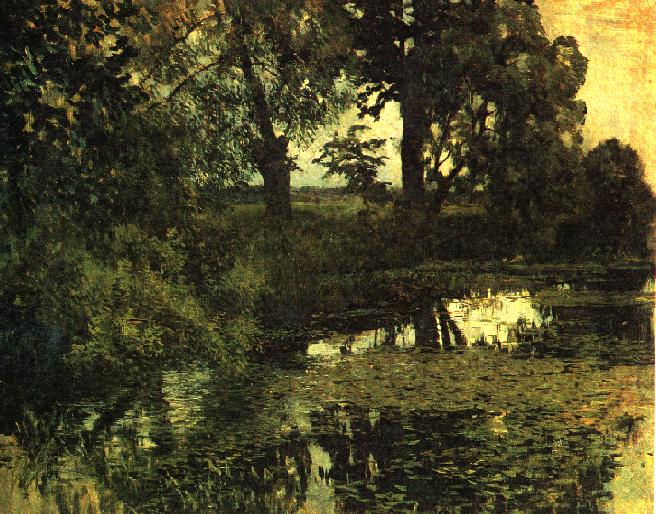
 In the late nineteenth century and the early twentieth, painters trying to convey the distinct character of Russia often seemed to turn to the extremes that water had to offer: either the vast expanse of great rivers and lakes, or the quiet backwater. Stagnant or weed-grown ponds, and the shaded backwaters of rivers, became an increasingly frequent subject for Russian landscape artists. The painting on the left by Apollinarii Vasnetsov dates from the early 1900s and has the title Quiet Water. Interestingly, Vasnetsov had shown himself about twenty years earlier to be equally adept at the expansive view of Russia. His painting with the significant title Motherland gives an extensive vision of a flat Russian countryside in which human dwellings nestle among small fields and garden plots.
In the late nineteenth century and the early twentieth, painters trying to convey the distinct character of Russia often seemed to turn to the extremes that water had to offer: either the vast expanse of great rivers and lakes, or the quiet backwater. Stagnant or weed-grown ponds, and the shaded backwaters of rivers, became an increasingly frequent subject for Russian landscape artists. The painting on the left by Apollinarii Vasnetsov dates from the early 1900s and has the title Quiet Water. Interestingly, Vasnetsov had shown himself about twenty years earlier to be equally adept at the expansive view of Russia. His painting with the significant title Motherland gives an extensive vision of a flat Russian countryside in which human dwellings nestle among small fields and garden plots.
A painting by Valentin Serov dating from 1888 has the same title as Polenov's: Overgrown Pond. Serov's landscape is more open, but this painting makes a pointed break with the convention of the ideal landscape, where the heavens are reflected in the mirror of the water. Serov's pond reflects sky as well as trees, but the compositional focus is neither the sky nor its reflection, but the large patches of duckweed and algae on the surface of the pond where the reflection of the heavens should be.

Yet a third master of the Russian landscape, Isaak Levitan, made a contribution to the genre. His Overgrown Pond (left) was painted in 1887, in more than one version. Like Serov's it has an open sky (much more open in one version), which heightens the effect of the pondweed intruding on the expected reflection.
Sometimes the expected reflection is trees rather than sky, and it's interesting to compare these paintings, which undermine one familiar landscape cliché, with paintings that focus on another: the inversion effect of trees mirrored in water.


